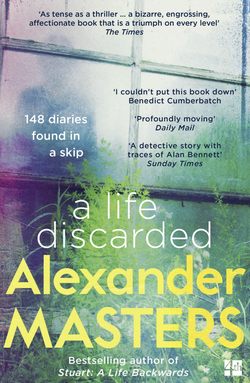Читать книгу A Life Discarded: 148 Diaries Found in a Skip - Alexander Masters, Alexander Masters - Страница 11
4 Flatface
ОглавлениеMay just look back on a life of struggle, at the age of sixty or so – and feel deeply sad, because in spite of various talents, of great beauty, have come to nothing.
Aged twenty-one
Six of the diaries in the thigh box are ‘Max-Val’ exercise books, stapled along the centre-fold, with paper made out of oat biscuits. The colour of these dreary little volumes is washed-out, Latin-class blue. Printed on the back of each is a set of Arithmetical Tables giving the lengths for cloth measure (2½ inches = 1 nail), the amount of grass needed to make up a ‘Truss’ (56lbs of Old Hay; 60lbs, New Hay; 36lbs of Straw), and, my favourite, ‘Apothecaries’ Weight for mixing medicines’: 20 grains = 1 Scruple.
Inside the books is a rapidly hand-drawn cartoon strip in blue ink. There are between two and eight frames per page. Nowadays it would be called a graphic novel. The scenes are of different sizes and always boxed in. The figures in the story are dressed in cloaks and repeatedly caught in moments of persecution or shock. The faces are distorted. But what’s going on is anybody’s guess.
The narrative does not progress obviously; it is like a set of flash photographs taken of a troupe of melodramatic puppets. The only constant figure is an androgynous and rhinoceros-nosed face:
This face is always viewed from the left, angled down, just off the silhouette. It appears in each frame of the cartoon – a total of well over two thousand times – and always produced in the same way, with nine fundamental lines: one for the forehead, two for the big nose, another to make the priggish upper lip, the chin and jaw are produced by a single wiggle that looks vaguely Arabic, a down stroke for a dimple and three quick movements to make up the eye. Hair (sometimes slicked, sometimes dishevelled) is a rush of slashes or curls on top. Most of the time this wig-wearing flatfish of a face doesn’t reflect much. It appears to be a force of creamy benignity. At its most irritating it represents poetic suffering. Sometimes it has a body coming off it, sometimes not. It is repeated so often that you begin to feel ill at the sight of the thing.
The flatface’s name is (usually) Clarence. It can also be called Rhubarb or Porbarb or John.
Sometimes he’s in prison:
with his two cellmates, the ‘Keeper’, who has a jaw like a casserole pot …
… and a rubber-faced monstrosity called Worful:
‘Clarence’ Flatface lives in the past. Sometimes he’s out of clink and down the tavern, being asked difficult maths questions …
“What’s two and two?”
… that he struggles to answer:
At other times, as ‘John’, Flatface is living at the time the cartoon is being drawn, in the early 1960s. In these contemporary frames ‘John’ might be lying in a fancy deckchair, with a Martini:
“I will have zis deckchair, & none uzzer” raged Irwin.
“Tomorrow, tomorrow!” was the carefree reply.
How did he get into this chair? Why is Irwin (who turns out to be Flatface’s brother) speaking in a German accent? What are those two people up in the air doing – planting carrots? Since when did deckchairs have foot canopies?
Once, as ‘Clarence’, Flatface becomes a king …
… which makes him grumpy.
Another time, Flatface’s days appear to be numbered:
This story never settles down – except for Flatface’s eternal presence. Every fifteen or twenty pages the strip is abruptly cut off and a whole side is given over to this disturbing profile:
Relieved, the writer then picks up the story again and presses on.
This isn’t a cartoon strip, it’s a set of narrative false starts ‘tethered by a face. But whose face? Not ‘I’s own, surely. A person this self-obsessed would want to explore his features, not freeze them. This face is a symbol for someone or something. Give it a few more years and it will evolve into a pictogram and join the Chinese alphabet.
There is only one occasion on which ‘I’ does not limit himself to the nine essential lines and allows Clarence to look at the reader full on. To emphasise the horror of the revelation, it is also the only time ‘I’ uses colour:
